Evapotranspiration in a Small Well-Vegetated Basin in Southwestern China
Abstract
1. Introduction
2. Materials and Methods
2.1. Study Domain and Materials
2.2. Research Methods
2.2.1. SWAT Model Construction
2.2.2. Climate Change and Land Use Change Scenario Setup
3. Results
3.1. Parameter Sensitivity Analysis
3.2. Model Calibration and Validation Results
3.3. ET Simulation Results
3.4. The Impact of Climate Change on ET
3.5. The Impact of Land Use Change on ET
4. Discussion
4.1. ET Variations Under Different Scenarios
4.2. Changes in ET from the Perspective of Water Balance
4.3. Drought and ET in Southwestern China
4.4. Study Limitations
5. Conclusions
Supplementary Materials
Author Contributions
Funding
Institutional Review Board Statement
Informed Consent Statement
Data Availability Statement
Conflicts of Interest
References
- Günen, M.A.; Atasever, U.H. Remote sensing and monitoring of water resources: A comparative study of different indices and thresholding methods. Sci. Total Environ. 2024, 926, 172117. [Google Scholar] [CrossRef]
- Scanlon, B.R.; Fakhreddine, S.; Rateb, A.; de Graaf, I.; Famiglietti, J.; Gleeson, T.; Grafton, R.Q.; Jobbagy, E.; Kebede, S.; Kolusu, S.R. Global water resources and the role of groundwater in a resilient water future. Nat. Rev. Earth Environ. 2023, 4, 87–101. [Google Scholar] [CrossRef]
- Oki, T.; Kanae, S. Global hydrological cycles and world water resources. Science 2006, 313, 1068–1072. [Google Scholar] [CrossRef]
- Kool, D.; Agam, N.; Lazarovitch, N.; Heitman, J.; Sauer, T.; Ben-Gal, A. A review of approaches for evapotranspiration partitioning. Agric. For. Meteorol. 2014, 184, 56–70. [Google Scholar] [CrossRef]
- Zhang, K.; Kimball, J.S.; Running, S.W. A review of remote sensing based actual evapotranspiration estimation. Wiley Interdiscip. Rev. Water 2016, 3, 834–853. [Google Scholar] [CrossRef]
- Yang, Y.; Roderick, M.L.; Guo, H.; Miralles, D.G.; Zhang, L.; Fatichi, S.; Luo, X.; Zhang, Y.; McVicar, T.R.; Tu, Z. Evapotranspiration on a greening Earth. Nat. Rev. Earth Environ. 2023, 4, 626–641. [Google Scholar] [CrossRef]
- Godoy, M.R.V.; Markonis, Y. Water cycle changes in reanalyses: A complementary framework. Sci. Rep. 2023, 13, 4795. [Google Scholar] [CrossRef]
- Zhao, F.B.; Ma, S.; Wu, Y.P.; Qiu, L.J.; Wang, W.K.; Lian, Y.Q.; Chen, J.; Sivakumar, B. The role of climate change and vegetation greening on evapotranspiration variation in the Yellow River Basin, China. Agric. For. Meteorol. 2022, 316, 108842. [Google Scholar] [CrossRef]
- Yang, D.; Yang, Y.; Xia, J. Hydrological cycle and water resources in a changing world: A review. Geogr. Sustain. 2021, 2, 115–122. [Google Scholar] [CrossRef]
- Gong, C.; Wang, W.; Zhang, Z.; Wang, H.; Luo, J.; Brunner, P. Comparison of field methods for estimating evaporation from bare soil using lysimeters in a semi-arid area. J. Hydrol. 2020, 590, 125334. [Google Scholar] [CrossRef]
- Liu, C.; Zhang, X.; Zhang, Y. Determination of daily evaporation and evapotranspiration of winter wheat and maize by large-scale weighing lysimeter and micro-lysimeter. Agric. For. Meteorol. 2002, 111, 109–120. [Google Scholar] [CrossRef]
- Su, Y.; Zhang, C.; Chen, X.; Liu, L.; Ciais, P.; Peng, J.; Wu, S.; Wu, J.; Shang, J.; Wang, Y. Aerodynamic resistance and Bowen ratio explain the biophysical effects of forest cover on understory air and soil temperatures at the global scale. Agric. For. Meteorol. 2021, 308, 108615. [Google Scholar] [CrossRef]
- Baldocchi, D.D. How eddy covariance flux measurements have contributed to our understanding of Global Change Biology. Glob. Change Biol. 2020, 26, 242–260. [Google Scholar] [CrossRef]
- Bambach, N.; Kustas, W.; Alfieri, J.; Prueger, J.; Hipps, L.; McKee, L.; Castro, S.; Volk, J.; Alsina, M.; McElrone, A. Evapotranspiration uncertainty at micrometeorological scales: The impact of the eddy covariance energy imbalance and correction methods. Irrig. Sci. 2022, 40, 445–461. [Google Scholar] [CrossRef]
- Jin, L.; Zhang, H.; He, Q.; Zhang, H. Comparison of the sensible heat flux determined by large-aperture Scintillometer and Eddy covariance measurements with respect to the energy balance problem in the Taklimakan Desert. Bound.-Layer Meteorol. 2022, 185, 365–393. [Google Scholar] [CrossRef]
- Singh, P.; Sehgal, V.K.; Dhakar, R.; Neale, C.M.; Goncalves, I.Z.; Rani, A.; Jha, P.K.; Das, D.K.; Mukherjee, J.; Khanna, M. Estimation of ET and crop water productivity in a semi-arid region using a large aperture scintillometer and remote sensing-based SETMI model. Water 2024, 16, 422. [Google Scholar] [CrossRef]
- Chen, J.M.; Liu, J. Evolution of evapotranspiration models using thermal and shortwave remote sensing data. Remote Sens. Environ. 2020, 237, 111594. [Google Scholar] [CrossRef]
- Zhao, G.; Gao, H.; Cai, X. Estimating lake temperature profile and evaporation losses by leveraging MODIS LST data. Remote Sens. Environ. 2020, 251, 112104. [Google Scholar] [CrossRef]
- Dembélé, M.; Ceperley, N.; Zwart, S.J.; Salvadore, E.; Mariethoz, G.; Schaefli, B. Potential of satellite and reanalysis evaporation datasets for hydrological modelling under various model calibration strategies. Adv. Water Resour. 2020, 143, 103667. [Google Scholar] [CrossRef]
- Lu, J.; Wang, G.; Chen, T.; Li, S.; Hagan, D.F.T.; Kattel, G.; Peng, J.; Jiang, T.; Su, B. A harmonized global land evaporation dataset from model-based products covering 1980–2017. Earth Syst. Sci. Data 2021, 13, 5879–5898. [Google Scholar] [CrossRef]
- Pan, S.; Pan, N.; Tian, H.; Friedlingstein, P.; Sitch, S.; Shi, H.; Arora, V.K.; Haverd, V.; Jain, A.K.; Kato, E. Evaluation of global terrestrial evapotranspiration using state-of-the-art approaches in remote sensing, machine learning and land surface modeling. Hydrol. Earth Syst. Sci. 2020, 24, 1485–1509. [Google Scholar] [CrossRef]
- Antonopoulos, V.Z.; Gianniou, S.K.; Antonopoulos, A.V. Artificial neural networks and empirical equations to estimate daily evaporation: Application to Lake Vegoritis, Greece. Hydrol. Sci. J.-J. Des Sci. Hydrol. 2016, 61, 2590–2599. [Google Scholar] [CrossRef]
- Baffaut, C.; Baker, J.M.; Biederman, J.A.; Bosch, D.D.; Brooks, E.S.; Buda, A.R.; Demaria, E.M.; Elias, E.H.; Flerchinger, G.N.; Goodrich, D.C.; et al. Comparative analysis of water budgets across the US long-term agroecosystem research network. J. Hydrol. 2020, 588, 125021. [Google Scholar] [CrossRef]
- Cai, Y.F.; Zhang, F.; Shi, J.C.; Johnson, V.C.; Ahmed, Z.; Wang, J.G.; Wang, W.W. Enhancing SWAT model with modified method to improve Eco-hydrological simulation in arid region. J. Clean. Prod. 2023, 403, 136891. [Google Scholar] [CrossRef]
- Dangol, S.; Zhang, X.S.; Liang, X.Z.; Anderson, M.; Crow, W.; Lee, S.; Moglen, G.E.; McCarty, G.W. Multivariate Calibration of the SWAT Model Using Remotely Sensed Datasets. Remote Sens. 2023, 15, 2417. [Google Scholar] [CrossRef]
- Merk, F.; Schaffhauser, T.; Anwar, F.; Tuo, Y.; Cohard, J.M.; Disse, M. The significance of the leaf area index for evapotranspiration estimation in SWAT-T for characteristic land cover types of West Africa. Hydrol. Earth Syst. Sci. 2024, 28, 5511–5539. [Google Scholar] [CrossRef]
- Abiodun, O.O.; Guan, H.; Post, V.E.A.; Batelaan, O. Comparison of MODIS and SWAT evapotranspiration over a complex terrain at different spatial scales. Hydrol. Earth Syst. Sci. 2018, 22, 2775–2794. [Google Scholar] [CrossRef]
- Dash, S.S.; Sahoo, B.; Raghuwanshi, N.S. Improved drought monitoring in teleconnection to the climatic escalations: A hydrological modeling based approach. Sci. Total Environ. 2023, 857, 159545. [Google Scholar] [CrossRef]
- Morsy, M.; Sayad, T.; Abdou, M.I.; Aboelkhair, H. Comparative study of evapotranspiration from the SWAT model and MODIS-derived remote sensing data in two climatic zones in Egypt. J. Water Clim. Change 2024, 15, 5219–5241. [Google Scholar] [CrossRef]
- Wang, L.; Chen, W.; Haung, G.; Wang, T.; Wang, Q.L.; Su, X.Y.; Ren, Z.X.; Chotamonsak, C.; Limsakul, A.; Torsri, K. Characteristics of super drought in Southwest China and the associated compounding effect of multiscalar anomalies. Sci. China-Earth Sci. 2024, 67, 2084–2102. [Google Scholar] [CrossRef]
- Wang, H.; Stephenson, S.R.; Qu, S.J. Quantifying the relationship between streamflow and climate change in a small basin under future scenarios. Ecol. Indic. 2020, 113, 106251. [Google Scholar] [CrossRef]
- Li, G.; Zhang, F.M.; Jing, Y.S.; Liu, Y.B.; Sun, G. Response of evapotranspiration to changes in land use and land cover and climate in China during 2001–2013. Sci. Total Environ. 2017, 596, 256–265. [Google Scholar] [CrossRef]
- Li, Z.; Xu, X.; Yu, B.; Xu, C.; Liu, M.; Wang, K. Quantifying the impacts of climate and human activities on water and sediment discharge in a karst region of southwest China. J. Hydrol. 2016, 542, 836–849. [Google Scholar] [CrossRef]
- Benavidez, R.; Jackson, B.; Maxwell, D.; Norton, K. A review of the (Revised) Universal Soil Loss Equation ((R)USLE): With a view to increasing its global applicability and improving soil loss estimates. Hydrol. Earth Syst. Sci. 2018, 22, 6059–6086. [Google Scholar] [CrossRef]
- Allen, M.; Dube, O.P.; Solecki, W.; Aragón-Durand, F.; Cramer, W.; Humphreys, S.; Kainuma, M.; Kala, J.; Mahowald, N.; Mulugetta, Y.; et al. Framing and Context. In Special Report: Global Warming of 1.5 °C; Cambridge University Press: Cambridge, UK, 2018. [Google Scholar]
- Valencia, S.; Villegas, J.C.; Hoyos, N.; Duque-Villegas, M.; Salazar, J.F. Streamflow response to land use/land cover change in the tropical Andes using multiple SWAT model variants. J. Hydrol.-Reg. Stud. 2024, 54, 101888. [Google Scholar] [CrossRef]
- Jafari, T.; Kiem, A.S.; Javadi, S.; Nakamura, T.; Nishida, K. Fully integrated numerical simulation of surface water-groundwater interactions using SWAT-MODFLOW with an improved calibration tool. J. Hydrol.-Reg. Stud. 2021, 35, 100822. [Google Scholar] [CrossRef]
- Ryter, D.W.; Alzraiee, A.H.; Niswonger, R.G. Simulation of the impacts of projected climate change on groundwater resources in the Urban, Semiarid Yucaipa Valley Watershed, Southern California using an integrated hydrologic model. J. Hydrol.-Reg. Stud. 2025, 60, 102461. [Google Scholar] [CrossRef]
- Wang, Y.F.; Jing, J.L.; Liu, H.H. Spatio—Temporal Variation of Evapotranspiration and Its Driving Factors in Southwest China from 2000 to 2020. Resour. Environ. Yangtze Basin 2023, 32, 2568–2580. [Google Scholar]
- Xie, R.H.; Wang, A.H. Comparison of Ten Potential Evapotranspiration Models and Their Attribution Analyses for Ten Chinese Drainage Basins. Adv. Atmos. Sci. 2020, 37, 959–974. [Google Scholar] [CrossRef]
- Zhao, J.C.; Liu, Q.Q.; Lu, H.L.; Wang, Z.; Zhang, K.; Wang, P. Future droughts in China using the standardized precipitation evapotranspiration index (SPEI) under multi-spatial scales. Nat. Hazards 2021, 109, 615–636. [Google Scholar] [CrossRef]
- Ma, N.; Zhang, Y.Q. Increasing Tibetan Plateau terrestrial evapotranspiration primarily driven by precipitation. Agric. For. Meteorol. 2022, 317, 108887. [Google Scholar] [CrossRef]
- Li, C.; Zhang, Y.; Shen, Y.; Kong, D.; Zhou, X. LUCC-driven changes in gross primary production and actual evapotranspiration in northern China. J. Geophys. Res. Atmos. 2020, 125, e2019JD031705. [Google Scholar] [CrossRef]
- Wang, Q.; Guan, Q.; Sun, Y.; Du, Q.; Xiao, X.; Luo, H.; Zhang, J.; Mi, J. Simulation of future land use/cover change (LUCC) in typical watersheds of arid regions under multiple scenarios. J. Environ. Manag. 2023, 335, 117543. [Google Scholar] [CrossRef]
- Wang, X.; Zhang, B.; Xu, X.; Tian, J.; He, C. Regional water-energy cycle response to land use/cover change in the agro-pastoral ecotone, Northwest China. J. Hydrol. 2020, 580, 124246. [Google Scholar] [CrossRef]
- Sun, S.; Chen, B.; Yan, J.; Van Zwieten, L.; Wang, H.; Dong, J.; Fu, P.; Song, Z. Potential impacts of land use and land cover change (LUCC) and climate change on evapotranspiration and gross primary productivity in the Haihe River Basin, China. J. Clean. Prod. 2024, 476, 143729. [Google Scholar] [CrossRef]
- Ma, T.J.; Chen, W.; Cai, Q.Y.; Dong, Z.Z.; Wang, L.; Hu, P.; Gao, L.; Garfinkel, C. Attribution analysis of the persistent and extreme drought in southwest China during 2022–2023. Environ. Res. Lett. 2024, 19, 114056. [Google Scholar] [CrossRef]
- Sun, X.P.; Wang, J.H.; Ma, M.G.; Han, X.J. Attribution of Extreme Drought Events and Associated Physical Drivers across Southwest China Using the Budyko Framework. Remote Sens. 2023, 15, 2702. [Google Scholar] [CrossRef]
- Sun, X.; Lai, P.; Wang, S.; Song, L.; Ma, M.; Han, X. Monitoring of extreme agricultural drought of the past 20 years in southwest China using GLDAS soil moisture. Remote Sens. 2022, 14, 1323. [Google Scholar] [CrossRef]
- Wang, M.; Ding, Z.; Wu, C.; Song, L.; Ma, M.; Yu, P.; Lu, B.; Tang, X. Divergent responses of ecosystem water-use efficiency to extreme seasonal droughts in Southwest China. Sci. Total Environ. 2021, 760, 143427. [Google Scholar] [CrossRef]
- Zhang, M.; He, J.; Wang, B.; Wang, S.; Li, S.; Liu, W.; Ma, X. Extreme drought changes in Southwest China from 1960 to 2009. J. Geogr. Sci. 2013, 23, 3–16. [Google Scholar] [CrossRef]
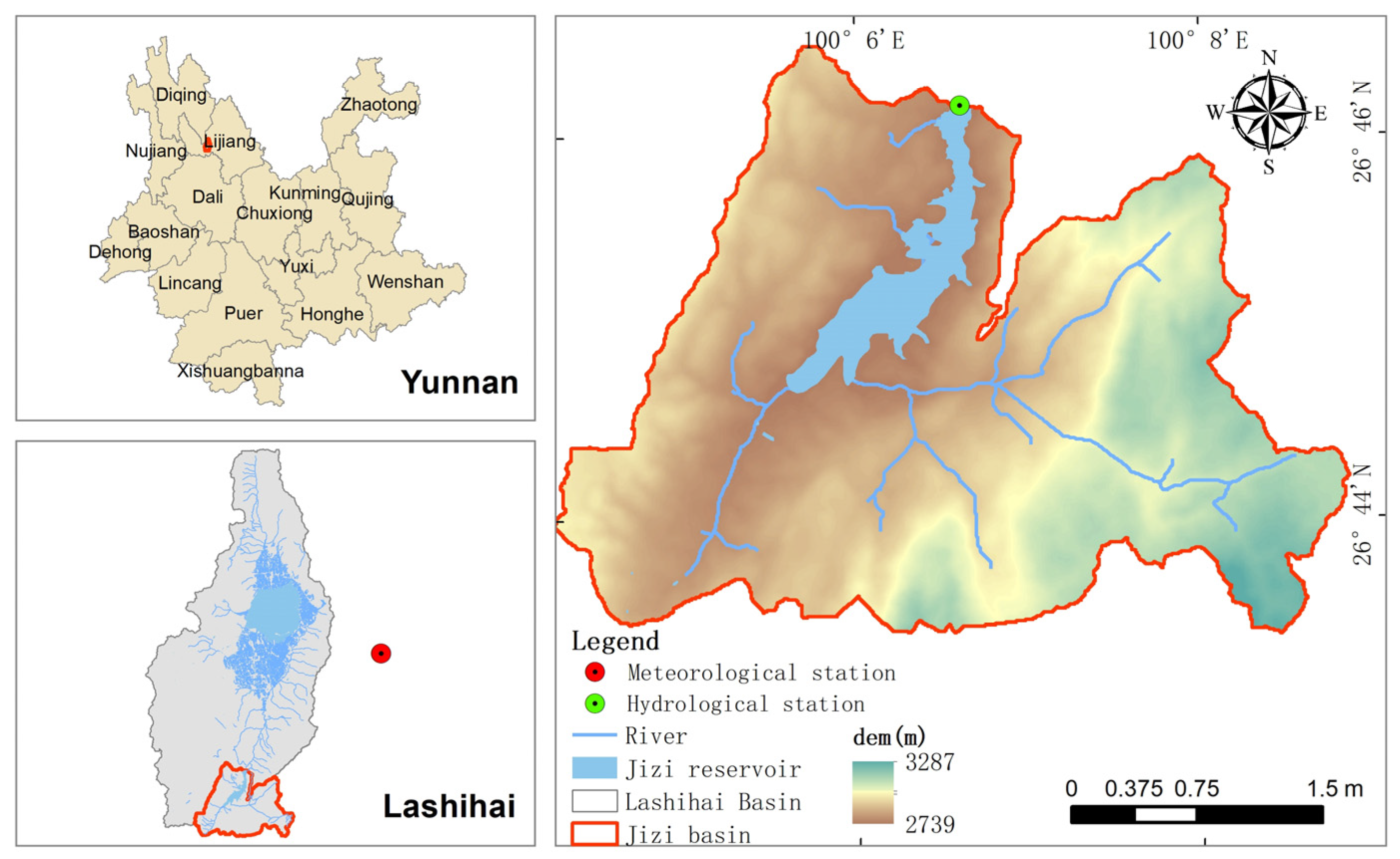

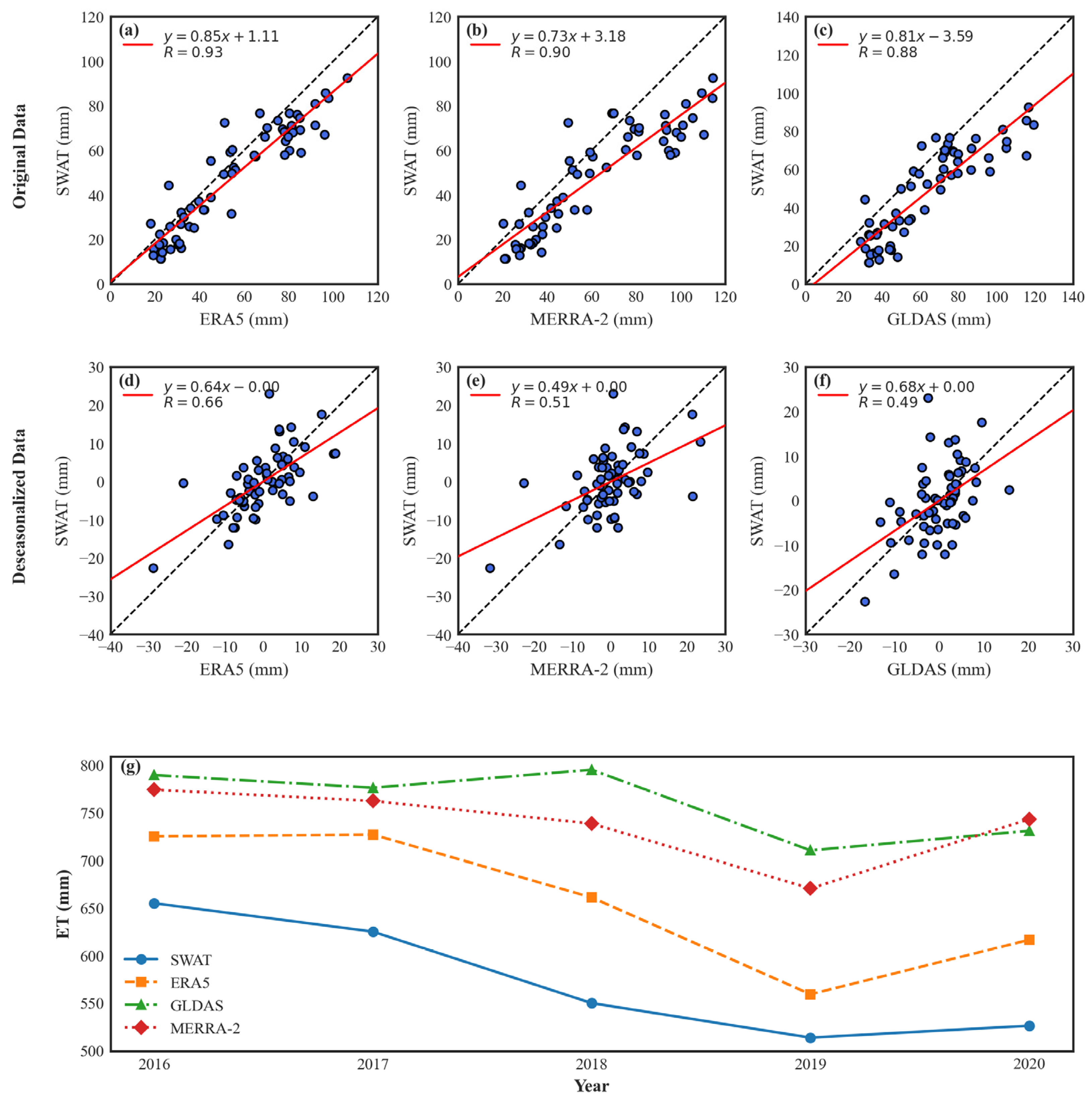
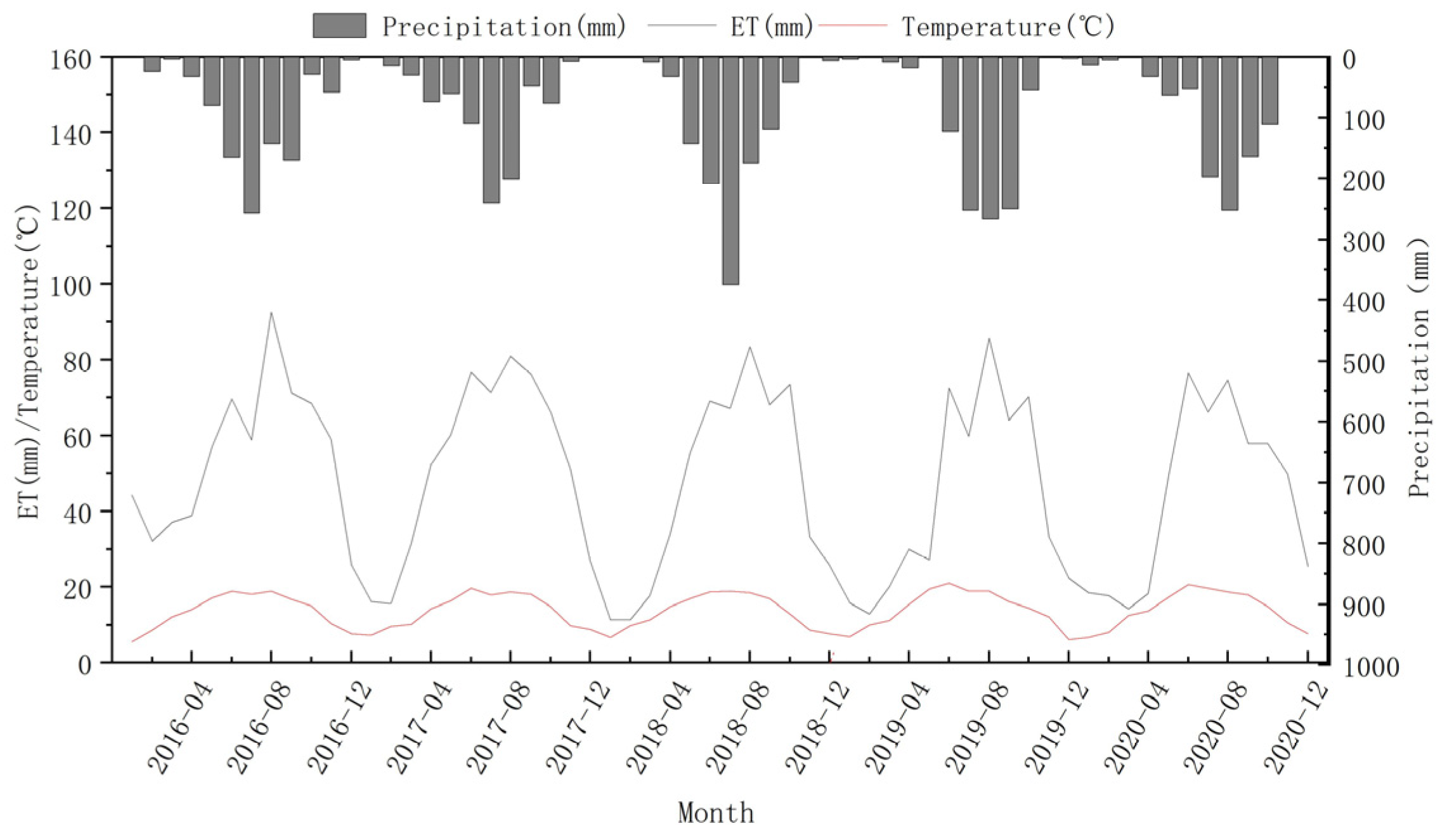
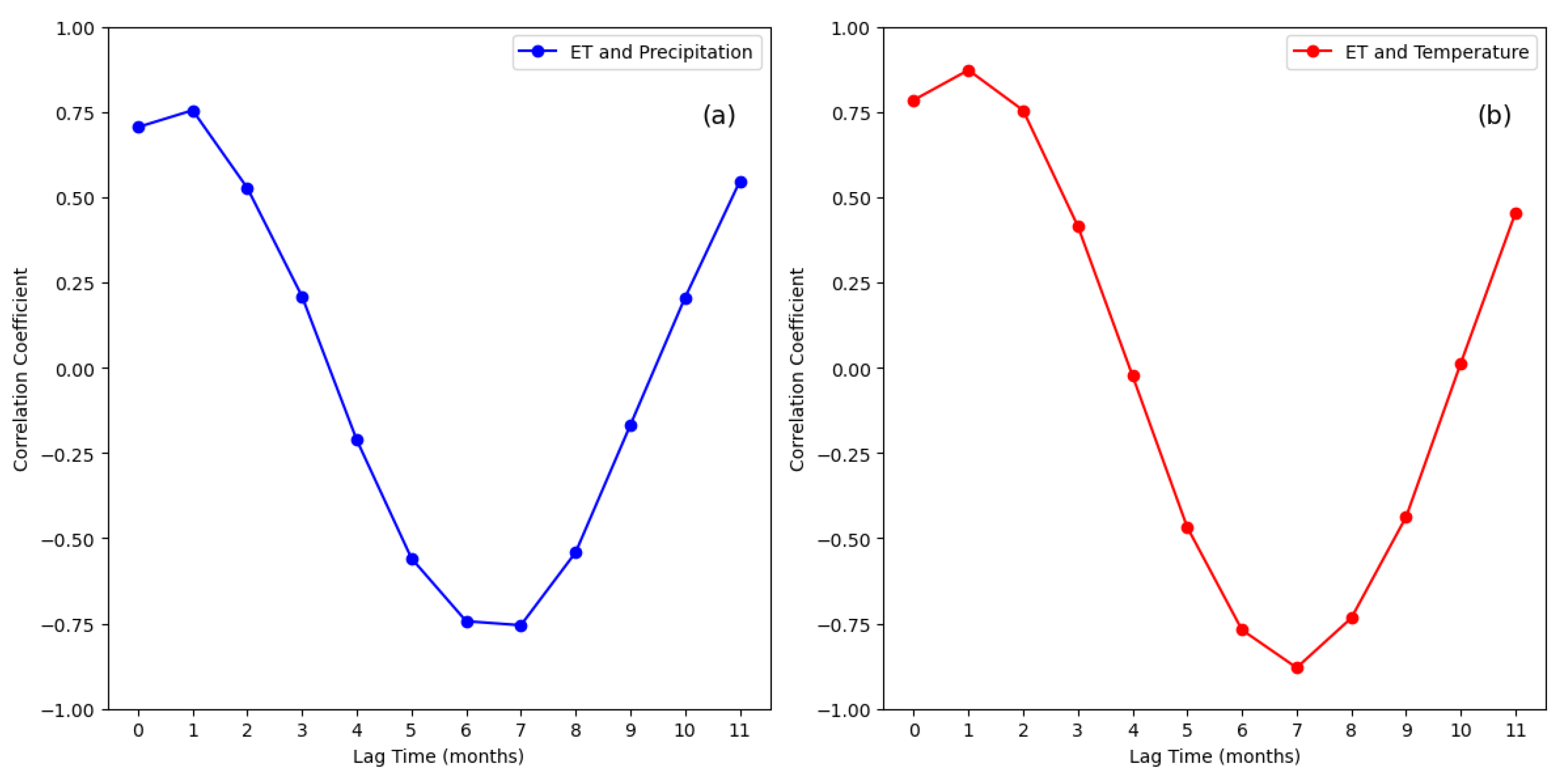

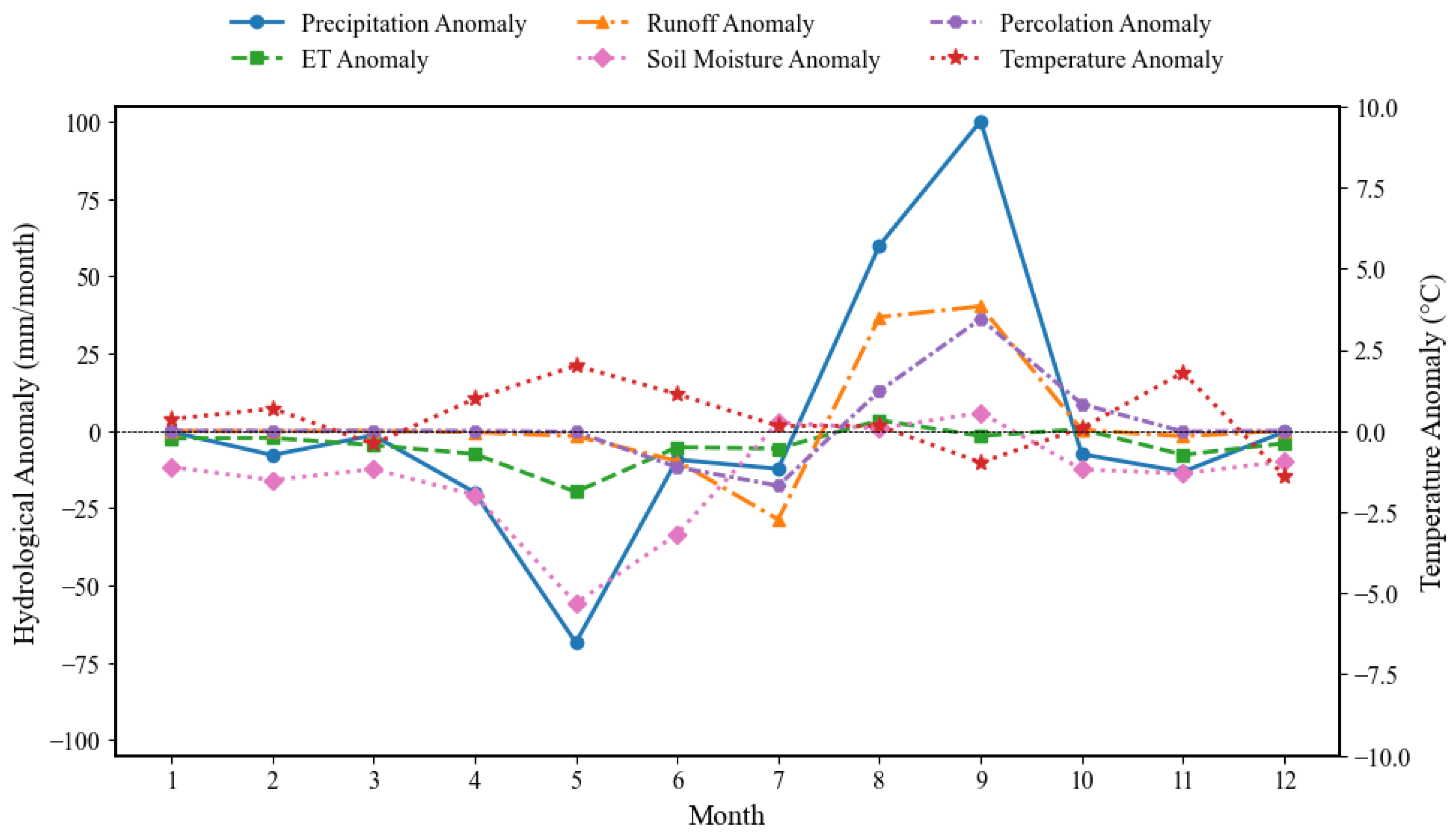
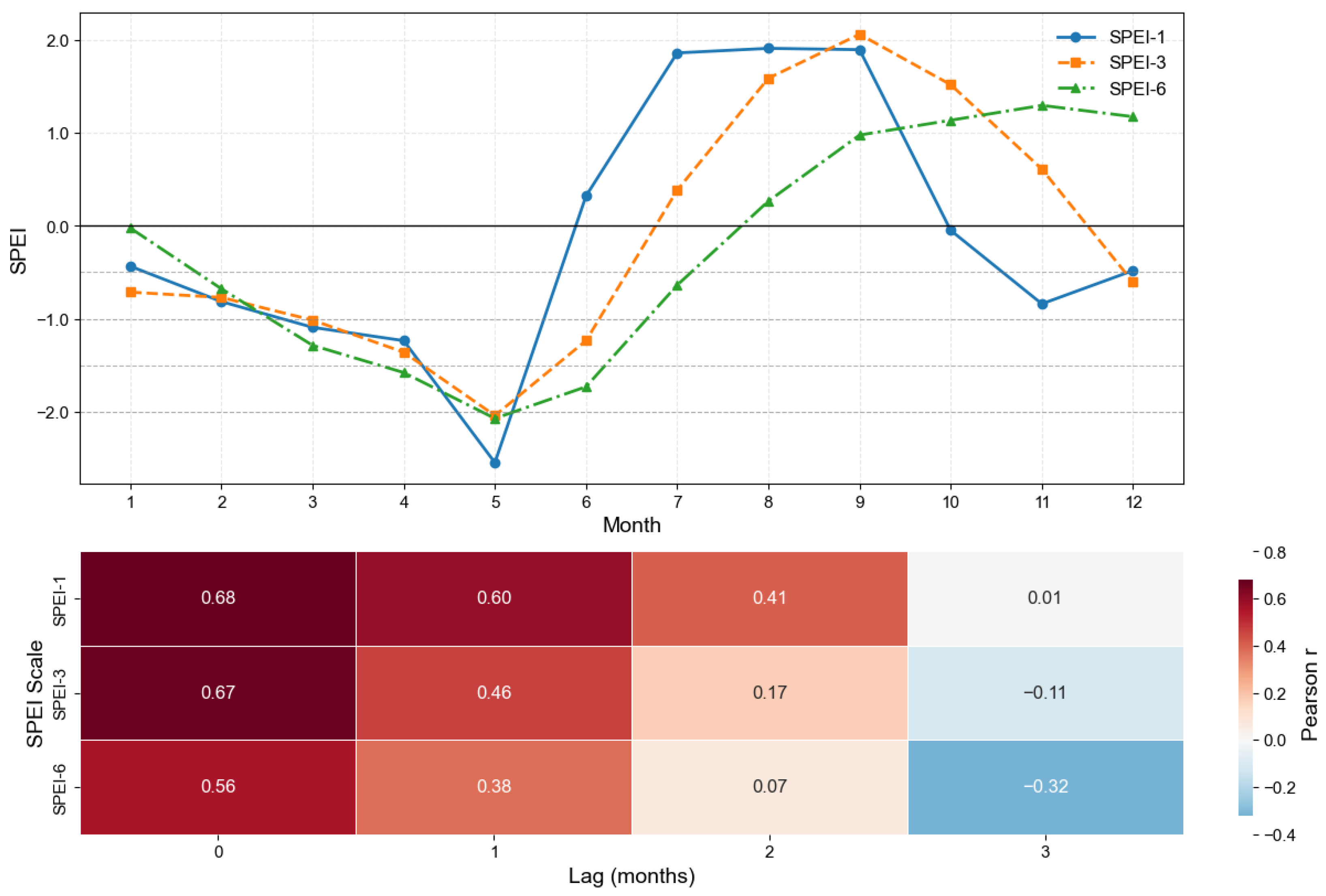
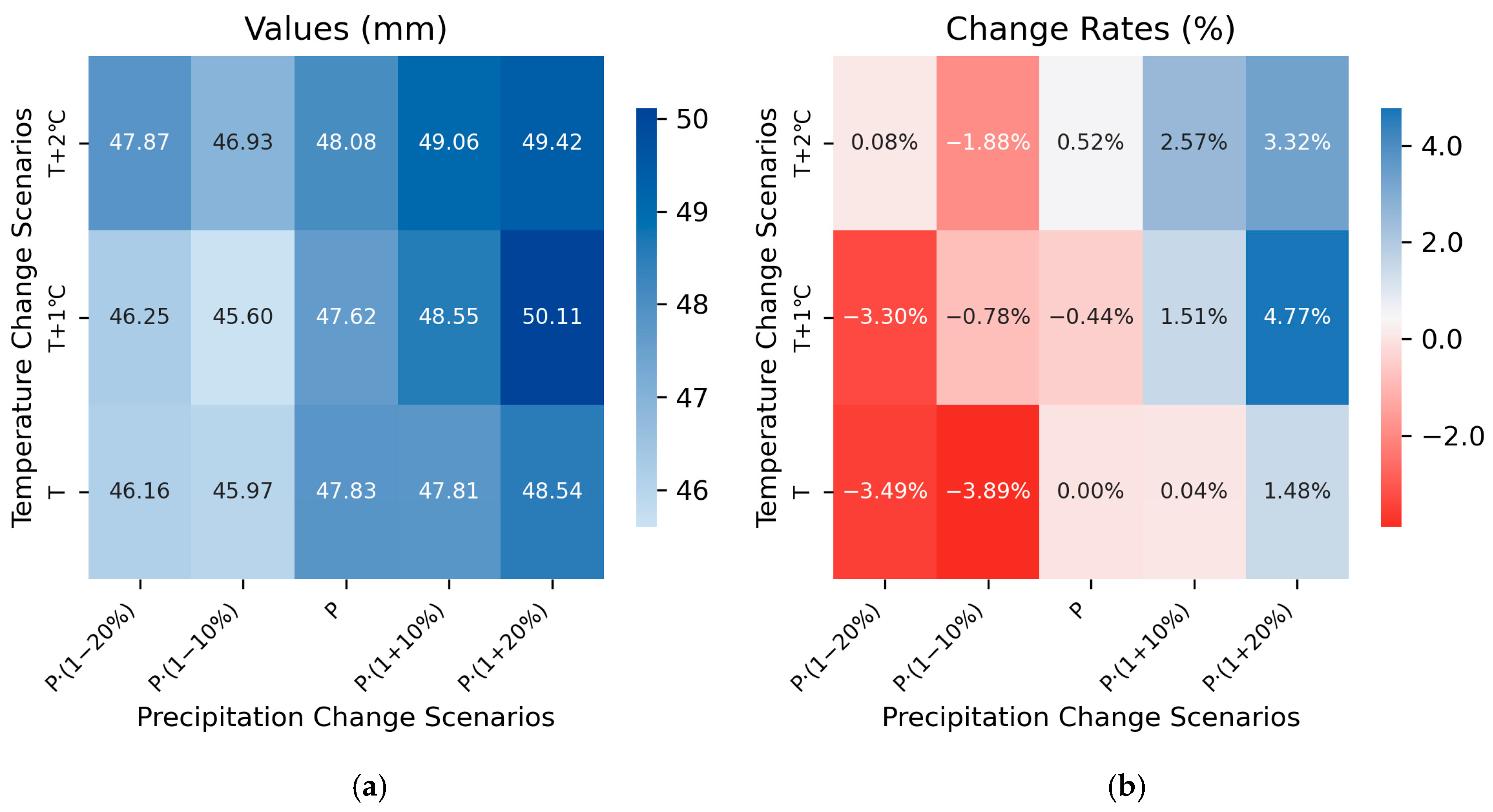

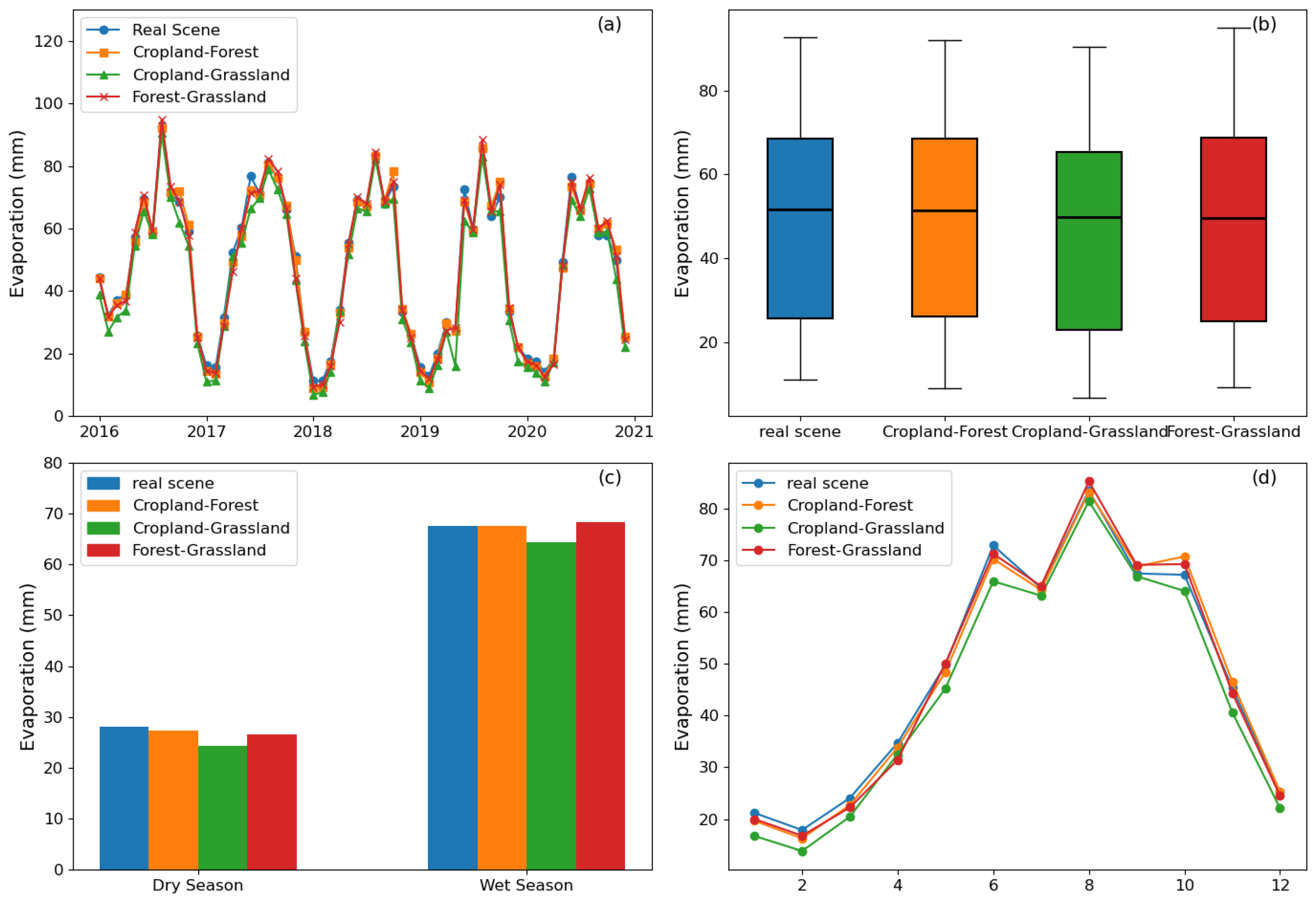
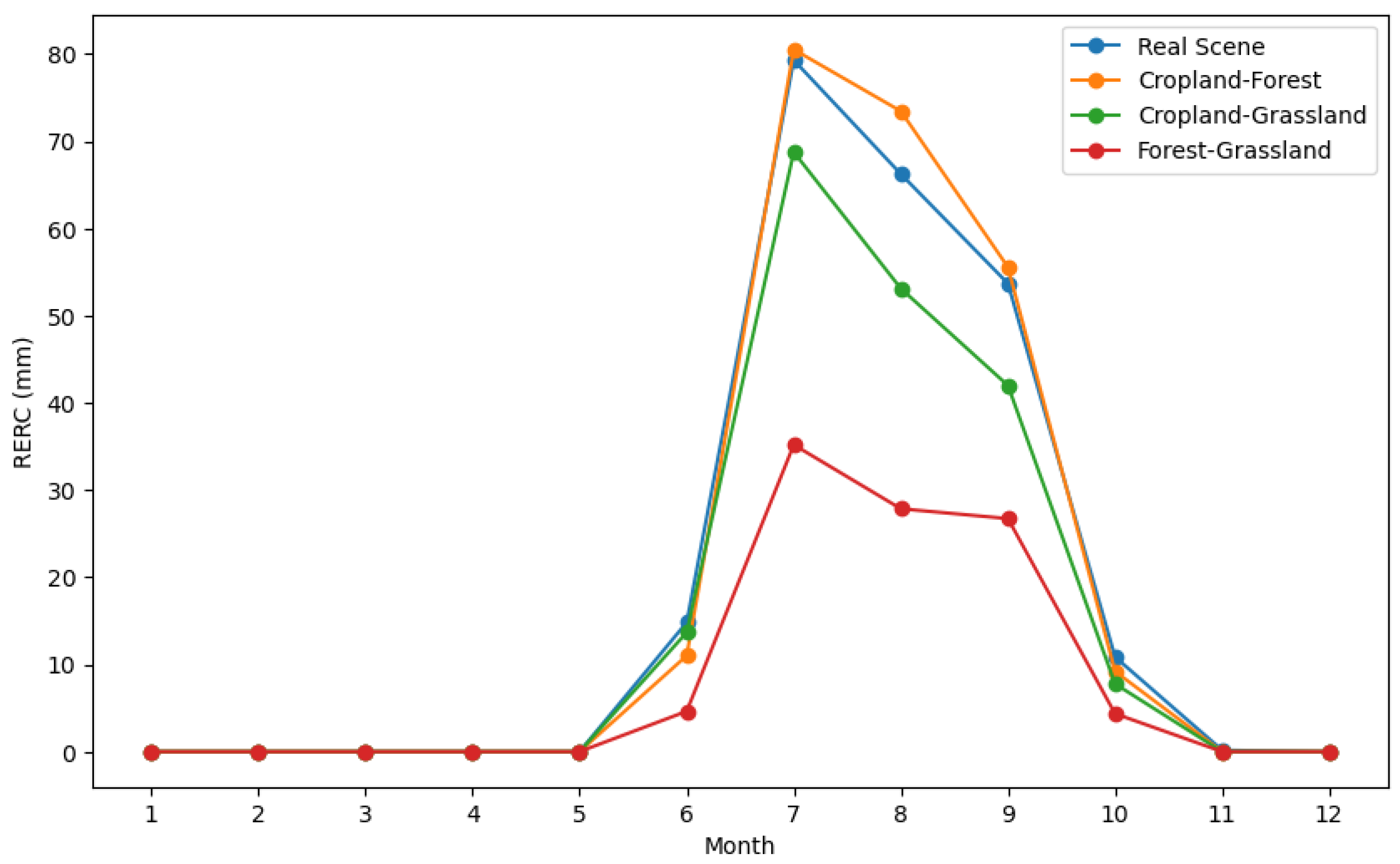
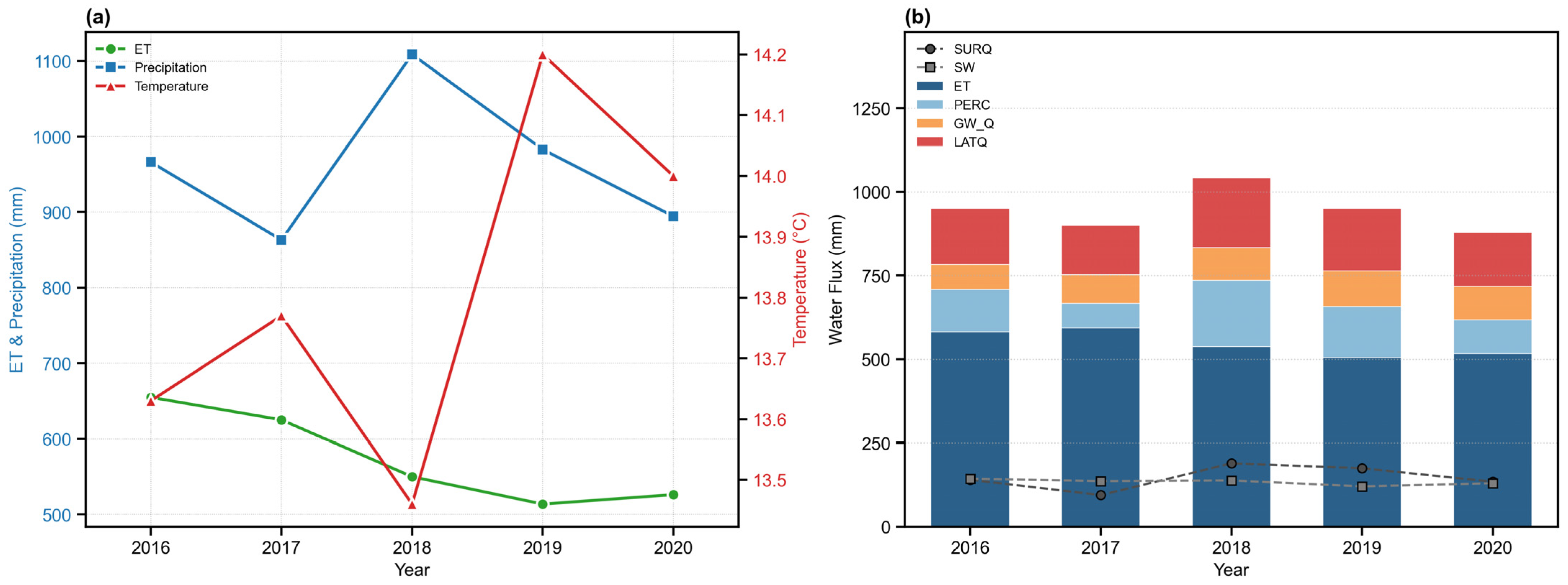
| Data Type | Main Parameters Included in the Data | Data Source |
|---|---|---|
| Digital Elevation Model (DEM) data | Elevation and Slope | NASA Official Website (https://search.asf.alaska.edu, accessed on 20 June 2025) |
| Land use data | 2017 Land Use Raster Data | National Earth System Science Data Center, National Science & Technology Infrastructure of China (http://www.geodata.cn, accessed on 20 June 2025) |
| Soil data | Soil Type, Soil Texture, Soil Organic Carbon Content, etc. | Harmonized World Soil Database v 1.2 (https://gaez.fao.org/pages/hwsd, accessed on 20 June 2025) |
| Meteorological Data | Daily Temperature, Humidity, Precipitation, etc., from 2016 to 2020 | China Meteorological Data Service Centre (https://data.cma.cn/, accessed on 20 June 2025) |
| observed hydrological data | Discharge in the Jizi Basin from 2016 to 2020 | Yulong Naxi Autonomous County Water Affairs Bureau |
| Number | Parameter Name | Description of Parameter | Range | Fitted Value | p-Value | t-Statistic |
|---|---|---|---|---|---|---|
| 1 | R_CN2 | Initial SCS runoff curve number for moisture condition II | −0.2–0.2 | −0.07 | 0.00 | −23.43 |
| 2 | R_SOL_AWC | Available water capacity (mm/mm) | −0.5–0.5 | 0.48 | 0.00 | 5.63 |
| 3 | R_SOL_BD | Moist bulk density (mg/m3) | 1.1–1.9 | 1.76 | 0.00 | 2.91 |
| 4 | V__ESCO | Soil evaporation compensation factor | 0–1 | 0.89 | 0.00 | −2.84 |
| 5 | R_GWQMN | Threshold depth of water in the shallow aquifer for return flow to occur (mm) | −0.5–0.5 | 0.31 | 0.08 | 1.74 |
| 6 | R_SOL_K | Saturated hydraulic conductivity | −0.5–0.5 | 0.31 | 0.12 | −0.17 |
| 7 | R_CANMX | Maximum canopy storage (mm) | −0.5–0.5 | 0.47 | 0.13 | 1.53 |
| 8 | R_OV_N | Manning’s “n” value for overland flow | −0.5–0.5 | 0.11 | 0.16 | 1.38 |
| 9 | V_ALPHA_BF | Baseflow alpha factor | 0–1 | 0.04 | 0.19 | −1.31 |
| 10 | V_CH_K2 | Effective hydraulic conductivity in main channel alluvium (mm/h) | 0–500 | 23.49 | 0.23 | −1.19 |
| 11 | R__SLSUBBSN | Average slope length (m) | −0.5–0.5 | 0.09 | 0.41 | 0.83 |
| 12 | R_HRU_SLP | Average slope steepness(m/m) | −0.5–0.5 | 0.32 | 0.49 | −0.69 |
| Climate Change Scenario | P·(1–20%) ET (mm)/ET Change Rate | P·(1–10%) ET (mm)/ET Change Rate | P ET (mm)/ET Change Rate | P·(1 + 10%) ET(mm)/ET Change Rate | P·(1 + 20%) ET (mm)/ET Change Rate |
|---|---|---|---|---|---|
| T + 2 °C | 47.87 (0.08%) | 46.93 (−1.88%) | 48.08 (0.52%) | 49.06 (2.57%) | 49.42 (3.32%) |
| T + 1 °C | 46.25 (−3.30%) | 46.50 (−2.78%) | 47.62 (−0.44%) | 48.55 (1.51%) | 50.11 (4.77%) |
| T | 46.16 (−3.49%) | 45.97 (−3.89%) | 47.83 (0.00%) | 47.81 (−0.04%) | 48.54 (1.48%) |
| Climate Change Scenarios | Range (mm) | Standard Deviation (mm) | |
|---|---|---|---|
| Temperature change scenarios | T + 2 °C | 2.49 | 0.89 |
| T + 1 °C | 3.86 | 1.42 | |
| T | 2.57 | 1.01 | |
| Precipitation change scenarios | P (1–20%) | 1.71 | 0.79 |
| P (1–10%) | 0.96 | 0.39 | |
| P | 0.46 | 0.19 | |
| P (1 + 10%) | 1.25 | 0.51 | |
| P (1 + 20%) | 1.57 | 0.64 |
| Land Use/Cover Scenarios | ET Value /(mm) | Comparison with Real Scene: Increment Value/(mm) | Comparison with Real Scene: Increment Rate (%) |
|---|---|---|---|
| Real Scene | 47.83 | 0 | 0 |
| Cropland–Forest | 47.51 | −0.32 | −0.67% |
| Cropland–Grassland | 44.43 | −3.4 | −7.10% |
| Forest–Grassland | 47.46 | −0.37 | −0.78% |
| Year | Evaporation (mm) /Change Rate (%) | Precipitation (mm) /Change Rate (%) | Temperature (°C) /Change Rate (%) |
|---|---|---|---|
| 2016 | 655.03 (0.14%) | 966.30 (0.00%) | 13.63 (−0.01%) |
| 2017 | 625.12 (0.09%) | 863.30 (−0.10%) | 13.77 (0.00%) |
| 2018 | 549.93 (−0.04%) | 1108.80 (0.15%) | 13.46 (−0.03%) |
| 2019 | 513.59 (−0.11%) | 983.00 (0.02%) | 14.20 (0.03%) |
| 2020 | 526.14 (−0.08%) | 894.50 (−0.07%) | 14.00 (0.01%) |
| average | 573.962 | 963.18 | 13.812 |
Disclaimer/Publisher’s Note: The statements, opinions and data contained in all publications are solely those of the individual author(s) and contributor(s) and not of MDPI and/or the editor(s). MDPI and/or the editor(s) disclaim responsibility for any injury to people or property resulting from any ideas, methods, instructions or products referred to in the content. |
© 2025 by the authors. Licensee MDPI, Basel, Switzerland. This article is an open access article distributed under the terms and conditions of the Creative Commons Attribution (CC BY) license (https://creativecommons.org/licenses/by/4.0/).
Share and Cite
Zhou, Z.; Li, Y.; Liang, L.; Li, C.; Jiao, Y.; Ma, Q. Evapotranspiration in a Small Well-Vegetated Basin in Southwestern China. Sustainability 2025, 17, 6816. https://doi.org/10.3390/su17156816
Zhou Z, Li Y, Liang L, Li C, Jiao Y, Ma Q. Evapotranspiration in a Small Well-Vegetated Basin in Southwestern China. Sustainability. 2025; 17(15):6816. https://doi.org/10.3390/su17156816
Chicago/Turabian StyleZhou, Zitong, Ying Li, Lingjun Liang, Chunlin Li, Yuanmei Jiao, and Qian Ma. 2025. "Evapotranspiration in a Small Well-Vegetated Basin in Southwestern China" Sustainability 17, no. 15: 6816. https://doi.org/10.3390/su17156816
APA StyleZhou, Z., Li, Y., Liang, L., Li, C., Jiao, Y., & Ma, Q. (2025). Evapotranspiration in a Small Well-Vegetated Basin in Southwestern China. Sustainability, 17(15), 6816. https://doi.org/10.3390/su17156816








